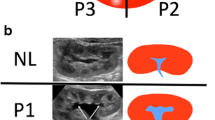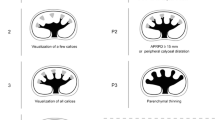Abstract
Background
Radiologists commonly evaluate children first diagnosed with urinary tract dilation on prenatal ultrasound (US).
Objective
To establish how North American pediatric radiologists define and report findings of urinary tract dilation on US.
Materials and methods
A web-based survey was sent to North American members of the Society for Pediatric Radiology (SPR) from January to February 2014. Reporting practices and interpretation of three image-based cases using free text were queried. Responses to close-ended questions were analyzed with descriptive statistics, while free-text responses to the three cases were categorized and analyzed as (1) using either descriptive terminology or an established numerical grading system and (2) as providing a quantitative term for the degree of dilation.
Results
Two hundred eighty-four pediatric radiologists answered the survey resulting in a response rate of 19.0%. There is a great variety in the terms used to describe urinary tract dilation with 66.2% using descriptive terminology, 35.6% using Society for Fetal Urology (SFU) grading system and 35.9% measuring anterior-posterior diameter (APD) of the renal pelvis. There is no consensus for a normal postnatal APD or the meaning of hydronephrosis. For the same images, descriptions vary widely in degree of severity ranging from normal to mild to severe. Similar variability exists among those using the SFU system. Ninety-seven percent say they believe a unified descriptive system would be helpful and 87.7% would use it if available.
Conclusion
Pediatric radiologists do not have a standardized method for describing urinary tract dilation but have a great desire for such a system and would follow it if available.





Similar content being viewed by others
References
Ismaili K, Hall M, Donner C et al (2003) Results of systematic screening for minor degrees of fetal renal pelvis dilatation in an unselected population. Am J Obstet Gynecol 188:242–246
Livera LN, Brookfield DS, Egginton JA et al (1989) Antenatal ultrasonography to detect fetal renal abnormalities: a prospective screening programme. BMJ 298:1421–1423
Sairam S, Al-Habib A, Sasson S et al (2001) Natural history of fetal hydronephrosis diagnosed on mid- trimester ultrasound. Ultrasound Obstet Gynecol 17:191–196
Siddique J, Lauderdale DS, VanderWeele TJ et al (2009) Trends in prenatal ultrasound use in the United States: 1995 to 2006. Med Care 47:1129–1135
You JJ, Alter DA, Stukel TA et al (2010) Proliferation of prenatal ultrasonography. CMAJ 182:143–151
Martin JA, Hamilton BE, Osterman MJK et al (2013) Births: final data for 2012. Natl Vital Stat Rep 62:1–27
Coplen DE, Austin PF, Yan Y et al (2006) The magnitude of fetal renal pelvic dilatation can identify obstructive postnatal hydronephrosis, and direct postnatal evaluation of management. J Urol 176:724–727
Lee RS, Cendron M, Kinnamon DD et al (2006) Antenatal hydronephrosis as a predictor of postnatal outcome: a meta-analysis. Pediatrics 118:586–593
Coelho GM, Bouzada MC, Pereira AK et al (2007) Outcome of isolated antenatal hydronephrosis: a prospective cohort study. Pediatr Nephrol 22:1727–1734
Barbosa JA, Chow JS, Benson CB et al (2012) Postnatal longitudinal evaluation of children diagnosed with prenatal hydronephrosis: insights in natural history and referral pattern. Prenat Diagn 32:1242–1249
Shamshiraz AA, Ravangard SF, Egan JF et al (2012) Fetal hydronephrosis as a predictor of neonatal urologic outcomes. J Ultrasound Med 31:947–954
Burnside ES, Sickles EA, Bassett LW et al (2009) The ACR BI-RADS® experience: learning from history. J Am Coll Radiol 6:851–860
D’Orsi CJ, Mendelson EB, Ikeda DM et al (2003) Breast imaging reporting and data system: ACR BI-RADS – breast imaging atlas. American College of Radiology, Reston
American College of Radiology (2011) Liver imaging reporting and data system version 2013.1. American College of Radiology website. www.acr.org/Quality-Safety/Resources/LIRADS. Published March 2011. Updated 2013. Accessed 1 June 2014
Fernbach SK, Maisels M, Conway JJ (1993) Ultrasound grading of hydronephrosis: introduction to the system used by the Society for Fetal Urology. Pediatr Radiol 23:478–480
Onen A (2007) An alternative grading system to refine the criteria for severity of hydronephrosis and optimal treatment guidelines in neonates with primary UPJ-type hydronephrosis. J Pediatr Urol 3:200–205
Riccabona M, Avni FE, Blickman JG et al (2008) Imaging recommendations in paediatric uroradiology: minutes of the ESPR workgroup session on urinary tract infections, fetal hydronephrosis, urinary tract ultrasonography and voiding cystourethrography, Barcelona, Spain, June 2007. Pediatr Radiol 38:138–145
Grignon A, Filion R, Filiatrault D et al (1986) Urinary tract dilatation in utero: classification and clinical applications. Radiology 160:645–647
Odibo AO, Raab E, Elovitz M et al (2004) Prenatal mild pyelectasis: evaluating the thresholds of renal pelvic diameter associated with normal postnatal renal function. J Ultrasound Med 23:513–517
Chitty LS, Altman DG (2003) Charts of fetal size: kidney and renal pelvis measurements. Prenat Diagn 23:891–897
Toiviainen-Salo S, Garel L, Grignon A et al (2004) Fetal hydronephrosis: is there hops for consensus? Pediatr Radiol 34:519–529
Kim SY, Kim MJ, Yoon CS et al (2013) Comparison of the reliability of two hydronephrosis grading systems: The Society for Foetal Urology grading system vs. the Onen grading system. Clin Radiol 68:e484–e490
Yoshida J, Tsuchiya M, Tatsuma N et al (2003) Mass screening for early detection of congenital kidney and urinary tract abnormalities in infancy. Pediatr Int 45:142–149
Tsai TC, Lee HC, Huang FY (1989) The size of the renal pelvis on ultrasonography in children. J Clin Ultrasound 17:647–651
Blane CE, DiPietro MA, Strouse PJ et al (2003) Pediatric renal pelvic fullness: an ultrasonographic dilemma. J Urol 170:201–203
Braga LH, Ruzhynsky V, Pemberton J et al (2014) Evaluating practice patterns in postnatal management of antenatal hydronephrosis: a national survey of Canadian pediatric urologists and nephrologists. Urology 83:909–914
Merguerian PA, Herz D, McQuiston L et al (2010) Variation mong pediatric urologists and across 2 continents in antibiotic prophylaxis and evaluation for prenatally detected hydronephrosis: a survey of American and European pediatric urologists. J Urol 184:1710–1715
Yiee JH, Tasian GE, Copp HL (2011) Management trends in prenatally detected hydronephrosis: national survey of pediatrician practice patterns and antibiotic use. Urology 78:895–901
Zanetta VC, Rosman BM, Bromley B et al (2012) Variations in management of mild prenatal hydronephrosis among maternal-fetal medicine obstetricians, and pediatric urologists and radiologists. J Urol 188:1935–1939
Acknowledgments
We thank Jennifer Boylan in the SPR office for assistance in distribution of our e-mail survey to the SPR membership and collecting data through surveymonkey.com.
Conflicts of interest
None
Author information
Authors and Affiliations
Corresponding author
Rights and permissions
About this article
Cite this article
Swenson, D.W., Darge, K., Ziniel, S.I. et al. Characterizing upper urinary tract dilation on ultrasound: a survey of North American pediatric radiologists’ practices. Pediatr Radiol 45, 686–694 (2015). https://doi.org/10.1007/s00247-014-3221-8
Received:
Revised:
Accepted:
Published:
Issue Date:
DOI: https://doi.org/10.1007/s00247-014-3221-8




